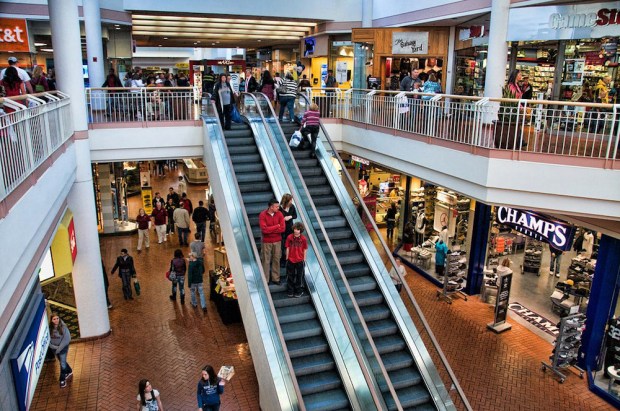Experts Predict More Retail Closures In 2018 Despite Strong Holiday Season

The holiday season is officially over, and the news was better than expected.
Sales were up 4.9 percent — the biggest year-over-year uptick since 2011 — and consumers set new records for the number of dollars spent. Online shopping had a strong year, reporting 18.1 percent growth since 2016 — though much of that was driven by a late season rally from customers getting their second shopping wind, according to Mastercard’s SpendingPulse report.
Mastercard’s data was echoed from other retail sources throughout the holiday shopping season.
First Data’s SVP of Competitive Intelligence Glenn Fodor told Karen Webster in an interview about a week before Christmas that holiday sales growth had been consistently good all season.
“Growth continues to be much stronger this year, no matter which way you slice it, than it has been in previous years,” Fodor told Webster in a conversation about First Data’s recently released SpendTrends holiday shopping report. Fodor noted the holiday performance in 2017 was consistent across the entire period, as opposed to the spikes and lags seen in previous seasons.
Preseason spending was up 5.7 percent — the first time since 2014 that bump has exceeded 5 percent. The post-Thanksgiving period was up 11.7 percent, nearly doubling the 5.6 percent growth observed last year. Although growth did slow a bit in the mid-season period that ended Dec. 12, the 6 percent increase was more than double the 2.7 percent logged in both 2014 and 2015 — and is still well ahead of the 3.7 percent growth observed last year.
“This season people are just spending more, that’s the long and the short of it,” said Fodor. “The preseason didn’t steal from the holiday season, and the holiday season wasn’t needed to make up for a weak preseason” — which is something all retailers like to hear; but physical retailers also had some good news in 2017.
Better Than Expected Season In-Store
“In terms of sheer, overall spend, we still love the store,” Mastercard’s Sarah Quinlan noted in an interview with PYMNTS.
However, that love is changing shape and form, and physical retailers are finally catching on to the change — and getting better at navigating it.
“Retailers did a better job, in my opinion, since they know 82 percent of people are using an online device while shopping — and even when you have them in your store, they are searching all the time,” Quinlan continued. “I think retailers this year made a better effort reaching out and using that channel to their advantage. This was the first year I think omnichannel had a meaning.”
Not only has the growth been strong, First Data’s Fodor told Webster, it’s also been consistent all season, across all points.
Retailers also had weather on their side this season, which was particularly helpful on the department store side, as it helped offset the continual weakness of the apparel segment. Quinlan believes physical retail’s “sales problem” is better understood as a “merchandise problem”: getting a retailer’s stock in line with consumers’ desires and needs.
All that, Fodor told Webster, combined with an upswing in the economy in terms of employment and wages, created a powerful result in retail this season.
“If you think about it logically, the consumer economy is strong, the economy is approaching full employment and the weather has finally been appropriate — not too hot and not too cold,” Fodor pointed out.
The better news — with a glance at both Mastercard and First Data’s figures — is that because those tangible fundamentals around high employment, low inflation and accelerating wages seem somewhat stable at present, it presages good things for the consumer economy in 2018.
“I haven’t seen anything that is going to knock the wind out of those sails in the immediate future. The good times are rolling,” Fodor predicted.
Rolling, perhaps, but that doesn’t mean the retail changes that were ignited in 2017 also won’t continue.
More Closures to Come
Strong retail season aside, the predictions going into 2018 for physical retail still trend toward the bearish. Experts mostly believe the record number of store closures the segment saw in 2017 will continue through 2018.
Physical stores trimmed their ranks by 7,000 last year — a 20-year high and a 229 percent increase year over year. Year to date, store closure announcements in the U.S. increased 229 percent year over year to some 6,985, according to an FGRT report emailed to Retail Dive.
Jan Kniffen, CEO of consulting firm J. Rogers Kniffen Worldwide Enterprises, said those troubling results — pushed by a disproportionately expanding eCommerce segment — will give way to the next round of closures already announced for early 2018, with more to follow.
Macy’s will be pushing forward with the planned closure of some 100 stores, and ailing specialty retailers like Toys R Us will also be shuttering a large number of locations. H&M and JCPenney have both announced closure plans that will run throughout the year.
Nick Egelanian, president of retail development consultants SiteWorks International, said in an email interview with Retail Dive that it’s a bit off base to blame all store closures on eCommerce, given longtime trends in segments like department stores — but that clearly more reshaping is on retail’s menu for the next 12 months.
